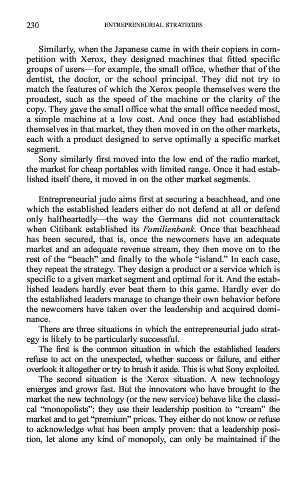Page 237 - ENTREPRENEURSHIP Innovation and entrepreneurship
P. 237
53231_Innovation and Entrepreneurship.qxd 11/8/2002 10:50 AM Page 230
230 ENTREPRENEURIAL STRATEGIES
Similarly, when the Japanese came in with their copiers in com-
petition with Xerox, they designed machines that fitted specific
groups of users—for example, the small office, whether that of the
dentist, the doctor, or the school principal. They did not try to
match the features of which the Xerox people themselves were the
proudest, such as the speed of the machine or the clarity of the
copy. They gave the small office what the small office needed most,
a simple machine at a low cost. And once they had established
themselves in that market, they then moved in on the other markets,
each with a product designed to serve optimally a specific market
segment.
Sony similarly first moved into the low end of the radio market,
the market for cheap portables with limited range. Once it had estab-
lished itself there, it moved in on the other market segments.
Entrepreneurial judo aims first at securing a beachhead, and one
which the established leaders either do not defend at all or defend
only halfheartedly—the way the Germans did not counterattack
when Citibank established its Familienbank. Once that beachhead
has been secured, that is, once the newcomers have an adequate
market and an adequate revenue stream, they then move on to the
rest of the “beach” and finally to the whole “island.” In each case,
they repeat the strategy. They design a product or a service which is
specific to a given market segment and optimal for it. And the estab-
lished leaders hardly ever beat them to this game. Hardly ever do
the established leaders manage to change their own behavior before
the newcomers have taken over the leadership and acquired domi-
nance.
There are three situations in which the entrepreneurial judo strat-
egy is likely to be particularly successful.
The first is the common situation in which the established leaders
refuse to act on the unexpected, whether success or failure, and either
overlook it altogether or try to brush it aside. This is what Sony exploited.
The second situation is the Xerox situation. A new technology
emerges and grows fast. But the innovators who have brought to the
market the new technology (or the new service) behave like the classi-
cal “monopolists”: they use their leadership position to “cream” the
market and to get “premium” prices. They either do not know or refuse
to acknowledge what has been amply proven: that a leadership posi-
tion, let alone any kind of monopoly, can only be maintained if the

